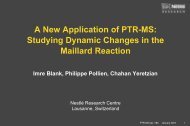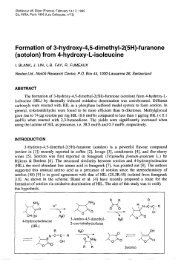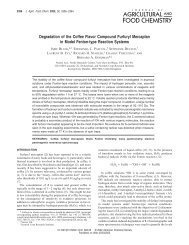The Flavor Principle of Fenugreek - Dr. Imre Blank's Homepage
The Flavor Principle of Fenugreek - Dr. Imre Blank's Homepage
The Flavor Principle of Fenugreek - Dr. Imre Blank's Homepage
You also want an ePaper? Increase the reach of your titles
YUMPU automatically turns print PDFs into web optimized ePapers that Google loves.
<strong>The</strong> <strong>Flavor</strong> <strong>Principle</strong> <strong>of</strong> <strong>Fenugreek</strong><br />
I. Blank, Nestlé Research Center<br />
211 th ACS Symposium, New Orleans, March 24-28, 1996<br />
• SPICE : <strong>Fenugreek</strong> (Trigonella foenum-graecum L.)<br />
• FLAVOR : Strong, spicy, seasonig-like, sweet<br />
• CHEMISTRY : Formation <strong>of</strong> sotolon<br />
OH<br />
NH 2<br />
OH<br />
NH 2<br />
O<br />
OH<br />
O<br />
O<br />
O<br />
O<br />
4-Hydroxy-L-isoleucine<br />
(HIL)<br />
HIL-Lactone<br />
Sotolon<br />
NESTLE RESEARCH CENTER<br />
PAGE 1
Structure <strong>of</strong> the presentation<br />
CHEMISTRY<br />
FLAVOR<br />
FENUGREEK<br />
NESTLE RESEARCH CENTER<br />
PAGE 2
<strong>Fenugreek</strong> is used as a food and flavoring<br />
• BOTANY : Trigonella foenum-graecum (Fabaceae)<br />
Annual herb with pods containing 10-20 seeds<br />
• OCCURRENCE : Cultivated in North Africa, France, India<br />
• USE : <strong>Flavor</strong>ing (curries, condiments, pickles, chutneys)<br />
Food (mixed with flour for bread, yellow dye)<br />
NESTLE RESEARCH CENTER PAGE 3
4-Hydroxy-L-isoleucine (HIL) is the major<br />
free amino acid in fenugreek<br />
• CONCENTRATION :<br />
5-7 g HIL/kg seeds<br />
about 80% <strong>of</strong> total free amino acids<br />
(Sauvaire et al., 4th Int. Workshop on seeds, Angers, France, 1993)<br />
• MATURATION :<br />
Maximum at 30-40 days after flowering<br />
10-12 g HIL/kg seed<br />
(Sauvaire et al., Phytochem.: 23, 479, 1984)<br />
OH NH 2<br />
OH<br />
O<br />
(2S,3R,4S)-HIL<br />
NESTLE RESEARCH CENTER PAGE 4
‘Sensory Directed Chemical Analysis’<br />
to elucidate key flavor compounds<br />
• Sample preparation : Direct extraction with diethyl ether,<br />
Purification by vacuum sublimation (Sen et al., JAFC 39: 757, 1991)<br />
• Screening <strong>of</strong> potent odorants : GC-Olfactometry (GC-O), Aroma<br />
Extract Dilution Analysis (Grosch, Trends Food Sci. Technol. 4: 68, 1993)<br />
• Identification : GC-MS<br />
• Quantification : Isotope Dilution Assay (IDA) using labeled<br />
sotolon as internal standard (Blank et al., JAFC, submitted)<br />
NESTLE RESEARCH CENTER PAGE 5
Sotolon is the character impact flavor compound<br />
<strong>of</strong> fenugreek<br />
Results <strong>of</strong> GC-Olfactometry :<br />
O<br />
OH<br />
O<br />
FD-factor : 10000<br />
O<br />
O<br />
O<br />
O<br />
O<br />
OH<br />
OH<br />
OH<br />
100<br />
10<br />
10<br />
10<br />
10<br />
OH<br />
OH<br />
O<br />
FD-factors<br />
O<br />
OH<br />
N<br />
N<br />
O<br />
N<br />
N<br />
O<br />
10<br />
10<br />
10<br />
10<br />
10<br />
NESTLE RESEARCH CENTER PAGE 6
‘Isotope Dilution Assay’ is an accurate<br />
quantification method <strong>of</strong> labile compounds<br />
Using labeled sotolon as internal standard<br />
Abundance<br />
150000<br />
100000<br />
50000<br />
Ion m/z 128<br />
sotolon<br />
12.56<br />
O<br />
OH<br />
O<br />
9.00 10.00 11.00 12.00 13.00 14.00<br />
Abundance<br />
80000<br />
60000<br />
40000<br />
20000<br />
Ion m/z 130<br />
labeled sotolon<br />
12.56<br />
*<br />
*<br />
O<br />
OH<br />
O<br />
9.00 10.00 11.00 12.00 13.00 14.00<br />
Retention time (min)<br />
NESTLE RESEARCH CENTER<br />
PAGE
Concentration <strong>of</strong> sotolon depends on the<br />
geographical origin and variety<br />
Sample Sotolon<br />
(mg/kg)<br />
<strong>Fenugreek</strong> (Egypt) 25<br />
<strong>Fenugreek</strong> (Australia) 4<br />
<strong>Fenugreek</strong> (India) 7<br />
<strong>Fenugreek</strong> (France) 2-6<br />
Curry powder (containing fenugreek) 40<br />
Liquid seasonings 0.1-90<br />
Odor threshold in water (detection/nasal) : 0.3 µg/L<br />
NESTLE RESEARCH CENTER PAGE 7
Sotolon is most likely formed from<br />
4-hydroxy-L-isoleucine (HIL)<br />
H +<br />
OH<br />
OH<br />
NH 2<br />
O<br />
(2S,3R,4S)-HIL<br />
O<br />
NH 2<br />
O<br />
R<br />
O<br />
O<br />
R<br />
H +<br />
R<br />
O<br />
OH<br />
O<br />
R<br />
O<br />
O<br />
(5S)-Sotolon<br />
NESTLE RESEARCH CENTER PAGE 8
<strong>The</strong> lactone <strong>of</strong> 4-hydroxy-L-isoleucine is a<br />
better precursor <strong>of</strong> sotolon than the amino acid<br />
Carbonyl compound<br />
Methylglyoxal<br />
2,3-Butanedione<br />
Sotolon yield (mol%)<br />
(from HIL-Lactone)<br />
35.9<br />
0.3<br />
Sotolon yield (mol%)<br />
(from HIL)<br />
7.4<br />
Lactonization <strong>of</strong> 4-hydroxy-L-isoleucine (HIL)<br />
is favored under acidic conditions<br />
Molar ratio HIL-Lactone / HIL<br />
0.6<br />
0.5<br />
0.4<br />
OH NH 2<br />
OH<br />
O<br />
0.3<br />
H +<br />
0.2<br />
0.1<br />
NH 2<br />
0<br />
pH 7 pH 6 pH 5 pH 4 pH 3<br />
O O<br />
HIL<br />
Reaction conditions : 100°C, 1 h, phosphate buffer<br />
Analytical technique : FAB-MS<br />
HIL-Lactone<br />
NESTLE RESEARCH CENTER<br />
PAGE 10
Sotolon is formed from 4-hydroxy-L-isoleucine<br />
by thermally induced oxidative deamination<br />
OH<br />
NH 2<br />
O<br />
MG<br />
OH<br />
O<br />
NH 2<br />
H + H N CH C<br />
H<br />
O<br />
O O O<br />
H 2 O<br />
O O<br />
H 2 O<br />
CH 3<br />
HO<br />
N<br />
CH<br />
C<br />
CH 3<br />
N<br />
OH<br />
H<br />
O<br />
O<br />
O<br />
O<br />
O<br />
CO 2<br />
H O 2<br />
N H 2<br />
O<br />
HO<br />
N<br />
HO<br />
H 2 O HO<br />
N H 2<br />
O<br />
O<br />
Strecker aldehyde<br />
O<br />
Sotolon<br />
OH<br />
O<br />
NESTLE RESEARCH CENTER<br />
PAGE 11
Formation <strong>of</strong> sotolon from HIL and its lactone :<br />
Influence <strong>of</strong> pH<br />
60.0<br />
50.0<br />
Methylglyoxal + HIL-Lactone<br />
Methylglyoxal + HIL<br />
Yield (mol %)<br />
40.0<br />
30.0<br />
20.0<br />
10.0<br />
0.0<br />
2.5 3.5 4.5 5.5 6.5 7.5<br />
pH<br />
NESTLE RESEARCH CENTER PAGE 12
Influence <strong>of</strong> the reaction time :<br />
Continuous increase <strong>of</strong> sotolon within 10 h<br />
30.0<br />
25.0<br />
Yield (mol %)<br />
20.0<br />
15.0<br />
10.0<br />
5.0<br />
Methylglyoxal + HIL<br />
0.0<br />
0 5 10 15 20 25<br />
Time (h)<br />
NESTLE RESEARCH CENTER PAGE 13
Effect <strong>of</strong> the temperature :<br />
Sotolon formation is favored at T > 80°C<br />
8.0<br />
Yield (mol %)<br />
7.0<br />
6.0<br />
5.0<br />
4.0<br />
3.0<br />
2.0<br />
1.0<br />
0.0<br />
Methylglyoxal + HIL<br />
20 40 60 80 100<br />
Temperature (°C)<br />
NESTLE RESEARCH CENTER PAGE 14
<strong>The</strong> key flavor compound <strong>of</strong> fenugreek and<br />
its formation from precursors is elucidated<br />
Limiting factors :<br />
Lactonization <strong>of</strong> 4-hydroxy-L-isoleucine (HIL)<br />
HIL-Lactone is a better precursor than HIL<br />
Reactivity <strong>of</strong> carbonyl compounds<br />
Methylglyoxal is an efficient reactant<br />
Optimal conditions :<br />
pH : pH optimum 5-6<br />
Time : continuous increase (10 fold within 10 h)<br />
Temperature : significant amounts at > 80°C<br />
NESTLE RESEARCH CENTER PAGE 15
Several skillful people contributed to this<br />
work<br />
Mrs. Jianming LIN : Diploma work<br />
Mrs. Stéphanie DEVAUD : Preparation <strong>of</strong> flavor extracts<br />
<strong>Dr</strong>. Laurent FAY : MS measurements<br />
Mr. René FUMEAUX : Synthesis <strong>of</strong> HIL<br />
<strong>Dr</strong>. Dieter WELTI : NMR measurements<br />
NESTLE RESEARCH CENTER PAGE 16






